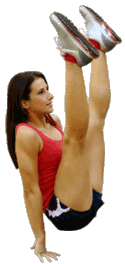At WiseGEEK, we're committed to delivering accurate, trustworthy information. Our expert-authored content is rigorously fact-checked and sourced from credible authorities. Discover how we uphold the highest standards in providing you with reliable knowledge.
What is a Reverse Lunge?
A reverse lunge is a lower body exercise that targets the hamstrings, glutes, quadriceps and hip muscles. A reverse lunge is an effective muscle-building exercise that also improves muscle and joint flexibility. As the name implies, a reverse lunge requires the athlete to perform the opposite motion that forward lunges require. The exercise involves taking a large step backward and then lowering the body toward the ground before eventually returning to the starting position.
In order to perform a reverse lunge, the athlete begins by standing erect with the legs shoulder width apart. The athlete then takes a step back with one leg. This step needs to be rather large in order for the athlete to have correct form during the second portion of the exercise. The back should remain straight throughout the exercise, and the feet should point forward. The arms should hang loosely at the athlete's sides throughout the entire exercise.

After taking the step back, the athlete bends the legs in order to lower the body toward the ground. He or she should continue to lower the body until the thigh of the front leg is parallel to the floor. At that point, the front knee should be directly above the front foot, and the back leg should be bent at a 90 degree angle, with the knee just above the floor. The front foot should remain flat on the floor throughout the exercise, but the heel of the back foot should lift slightly.
At this point, the athlete can do one of two things, depending on which variation of the reverse lunge he or she is performing. After reaching the lowest point of the reverse lunge, the athlete can choose to return all the way to the original standing position before performing the same sequence with the other leg. Because of the amount of motion that this variation of the reverse lunge requires, it will increase the amount of aerobic exercise that the athlete achieves as a result of the exercise.
Alternatively, after a brief pause at the lowest point, the athlete can choose to straighten the legs back to the original reverse lunge position before lowering toward the floor again. When performing this version of the reverse lunge, the athlete completes all of the repetitions with one leg forward before returning to the original standing position and repeating the exercise with the other leg in the front position. This will provide each leg with a focused and extended workout.
Regardless of which variation an athlete chooses, reverse crunches are an excellent quadriceps exercise, and they provide a good workout for the hips and hamstrings. The size of the step also helps to increase the flexibility of the hamstrings and hip joints and even provides a slight stretch for the calves. Athletes who want to increase the intensity of the exercise can hold weights in their hands, which will put more strain on the muscles as they perform the exercise.
AS FEATURED ON:
AS FEATURED ON:










Discuss this Article
Post your comments